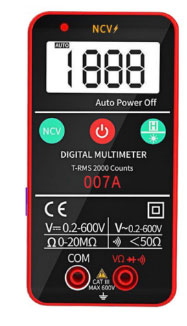Usage of Screwdriver Electroprobe
(1) Formula for judging AC and DC: the pen judges AC and DC. AC is bright and DC is dark. AC neon tube is bright all over, and DC neon tube is bright at one end.
Note: first, tell the reader that before using the low-voltage electric pen, it must be tested on the confirmed charged body; Do not use the electric pen until it is confirmed that it is normal. When judging AC and DC, it is best to compare the "two currents", which is very obvious. When measuring alternating current, both ends of the neon tube shine at the same time. When measuring direct current, only one end of the neon tube shines.
(2) Pithy formula for judging the positive and negative poles of DC: judge the positive and negative poles with an electric pen, and observe the neon tube carefully. The bright front end is the negative pole, and the bright rear end is the positive pole.
Note: the front end of the neon tube refers to one end of the pen tip of the test pen, and the rear end of the neon tube refers to one end held by hand. The bright front end is the negative pole, and vice versa. Pay attention to: the power supply voltage is 110V and above; If the person is insulated from the earth, one hand touches either pole of the power supply, the other hand holds the measuring pen, the metal head of the pen touches the other pole of the measured power supply, the front pole of the neon tube lights up, and the power supply touched is the negative pole; If the rear end pole of the neon tube lights up, the power supply of the measured contact is the positive pole, which is based on the principle of DC unidirectional flow and electron flow from the negative pole to the positive pole.
(3) The formula for judging whether the DC power supply is grounded or not and the difference between positive and negative grounding: the DC coefficient of the substation and the electric pen does not shine when touched; If the light is close to the tip of the pen, the positive electrode has a ground fault; If the light is close to the finger end, the ground fault is at the negative pole.
Note: the DC coefficient of power plant and substation is insulated from the ground. When people stand on the ground and touch the positive or negative electrode with an electric pen, the neon tube should not be lit. If it is lit, it indicates that the DC system is grounded; If the light is on the end near the pen tip, the positive electrode is grounded; If the light is on the end close to the finger, it is negative grounding.
(4) Pithy formula for judging in-phase and out of phase: judge that the two lines are the same and different, hold a pen in each hand, insulate the two feet from the ground phase, touch an important line with each pen, and watch a pen with your eyes. If it is not lit in phase, it is different.
Note: during this test, keep in mind that both feet must be insulated from the ground. Because most of China's power supply is 380 / 220V, and the transformer generally adopts neutral point direct grounding, so during the test, the human body and the earth must be insulated to avoid forming a circuit and misjudgment; During the test, the two strokes on and off display are the same, so only one can be viewed.
(5) Formula for judging the grounding fault of phase line of 380 / 220V three-phase three wire power supply line: star connected three-phase line, two electric pens touch bright, the remaining one is weak, and the phase conductor has been grounded; If the light is almost invisible, there is a fault in the metal grounding.
Note: the secondary side of the power transformer is generally connected in Y shape. In the three-phase three wire system with ungrounded neutral point, when using the power inspection pen and three phase lines, two are slightly brighter than usual, while the brightness on the other is weaker, which means that the phase line with weak brightness is grounded, but it is not too serious; If two are very bright and the remaining one is almost invisible, there is a metal grounding fault in this phase line.













